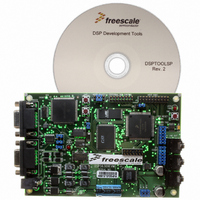DSP56309EVM Freescale Semiconductor, DSP56309EVM Datasheet - Page 169

DSP56309EVM
Manufacturer Part Number
DSP56309EVM
Description
KIT EVALUATION FOR XC56309
Manufacturer
Freescale Semiconductor
Type
DSPr
Specifications of DSP56309EVM
Contents
Module Board, Installation Guide, Power Supply, Cable, Software and more
Description/function
Audio DSPs
Product
Audio Modules
For Use With/related Products
DSP56309
Lead Free Status / RoHS Status
Contains lead / RoHS non-compliant
- Current page: 169 of 284
- Download datasheet (4Mb)
Serial Communication Interface (SCI)
The SCI provides a full-duplex port for serial communication with other DSPs, microprocessors,
or peripherals such as modems. The SCI interfaces without additional logic to peripherals that
use TTL-level signals. With a small amount of additional logic, the SCI can connect to peripheral
interfaces that have non-TTL level signals, such as RS-232, RS-422, and so on. This interface
uses three dedicated signals: transmit data, receive data, and SCI serial clock. It supports
industry-standard asynchronous bit rates and protocols, as well as high-speed synchronous data
transmission. SCI asynchronous protocols include a multidrop mode for master/slave operation
with wake-up on idle line and wake-up on address bit capability. This mode allows the
DSP56309 to share a single serial line efficiently with other peripherals.
The SCI consists of separate transmit and receive sections that can operate asynchronously with
respect to each other. A programmable baud rate generator supplies the transmit and receive
clocks. An enable vector and an interrupt vector are included so that the baud-rate generator can
function as a general-purpose timer when the SCI is not using it, or when the interrupt timing is
the same as that used by the SCI.
8.1 Operating Modes
The operating modes for the DSP56309 SCI are as follows:
These modes are selected by the SCR WD[2–0] bits. Synchronous data mode is essentially a
high-speed shift register for I/O expansion and stream-mode channel interfaces. A gated transmit
and receive clock compatible with the Intel 8051 serial interface mode 0 synchronizes data.
Asynchronous modes are compatible with most UART-type serial devices. Standard RS-232
communication links are supported by these modes. Multidrop Asynchronous mode is
Freescale Semiconductor
8-bit synchronous (shift register mode)
10-bit asynchronous (1 start, 8 data, 1 stop)
11-bit asynchronous (1 start, 8 data, 1 even parity, 1 stop)
11-bit asynchronous (1 start, 8 data, 1 odd parity, 1 stop)
11-bit multidrop asynchronous (1 start, 8 data, 1 data type, 1 stop)
This mode is used for master/slave operation with wake-up on idle line and wake-up on
address bit capability. It allows the DSP56309 to share a single serial line efficiently with
other peripherals.
DSP56309 User’s Manual, Rev. 1
8
8-1
Related parts for DSP56309EVM
Image
Part Number
Description
Manufacturer
Datasheet
Request
R
Part Number:
Description:
Manufacturer:
Freescale Semiconductor, Inc
Datasheet:
Part Number:
Description:
Manufacturer:
Freescale Semiconductor, Inc
Datasheet:
Part Number:
Description:
Manufacturer:
Freescale Semiconductor, Inc
Datasheet:
Part Number:
Description:
Manufacturer:
Freescale Semiconductor, Inc
Datasheet:
Part Number:
Description:
Manufacturer:
Freescale Semiconductor, Inc
Datasheet:
Part Number:
Description:
Manufacturer:
Freescale Semiconductor, Inc
Datasheet:
Part Number:
Description:
Manufacturer:
Freescale Semiconductor, Inc
Datasheet:
Part Number:
Description:
Manufacturer:
Freescale Semiconductor, Inc
Datasheet:
Part Number:
Description:
Manufacturer:
Freescale Semiconductor, Inc
Datasheet:
Part Number:
Description:
Manufacturer:
Freescale Semiconductor, Inc
Datasheet:
Part Number:
Description:
Manufacturer:
Freescale Semiconductor, Inc
Datasheet:
Part Number:
Description:
Manufacturer:
Freescale Semiconductor, Inc
Datasheet:
Part Number:
Description:
Manufacturer:
Freescale Semiconductor, Inc
Datasheet:
Part Number:
Description:
Manufacturer:
Freescale Semiconductor, Inc
Datasheet:
Part Number:
Description:
Manufacturer:
Freescale Semiconductor, Inc
Datasheet:










